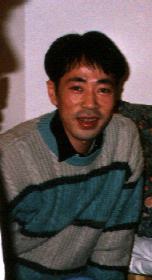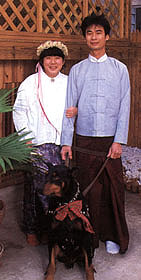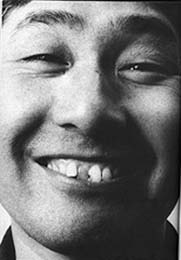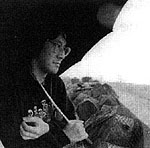About The Artists
from
Comics Underground Japan
Edited by Kevin Quigley
Copyright © 1996 by Blast Books

SUZY AMAKANE Born March 20, 1956, in Tokyo, Suzy Amakane enjoyed manga as a child, especially "Tetsuwan Atom" (Astro Boy) and the wacky "gag" strips of Fujio Akatsuka. But it was seeing a David Hockney exhibition when Amakane was twenty that set him on the road to a life in painting. From 1978 to 1982 he attended the Tama Art University, one of Japan's most prestigious fine-arts schools. Though admittedly a poor student, Suzy has since gone on to a remarkably successful career in both the fine and commercial arts. His early paintings parodied, with impressive skill, the styles and themes of his beloved masters, Hockney, Johns, Lichtenstein, and Magritte, and yet they remained uniquely indebted to the ebullient manga he read as a child. Suzy has since developed a sensuous and playful style all his own. His pictures-many of them featuring the wide-eyed scamp shown squatting on the front cover of Comics Underground Japan-teem with visual puns and pop-culture allusions. As well as having his work shown in magazines, on TV, and on CD jackets and labels, Suzy Amakane has been in many solo and group exhibitions in both Japan and Australia.
 SHIMODA EMIKO (a.k.a. CAROL SHIMODA) For most of the 1980s Shimoda Emiko was one of Japan's most popular and successful illustrators. Her portraits of both famous and obscure Japanese (Shimoda's people are always smiling) were regularly featured in magazines and advertising. Her work crosses all boundaries, achieving a style that is both ironic and celebratory, pleasant yet formally thrilling. For her comics work, Shimoda adopted a style parodying girls' romance manga of the 1960s. On the surface as charming as her portraits, Shimoda's manga is, however, even more double-edged. She delights in dropping shocking and incongruous elements into the confines of the popular romance aesthetic. In 1985, at the height of her fame, Shimoda picked up and moved to the United States, where she got married and settled in Queens. She voluntarily abandoned art for a number of years and, along with her husband (himself a Burmese immigrant), ran a laundry in her Corona neighborhood, and then a Karaoke bar on Manhattan's Upper West Side. In 1994 she returned to drawing and painting, prolifically completing over two hundred portraits within the summer, this time of American subjects from all walks of life (still smiling). She hopes to have a New York gallery exhibition of this recent work and envisions inviting all of her portrait subjects to the the opening. (Pictured here with husband Li Lung-Chun and Bobby)
SHIMODA EMIKO (a.k.a. CAROL SHIMODA) For most of the 1980s Shimoda Emiko was one of Japan's most popular and successful illustrators. Her portraits of both famous and obscure Japanese (Shimoda's people are always smiling) were regularly featured in magazines and advertising. Her work crosses all boundaries, achieving a style that is both ironic and celebratory, pleasant yet formally thrilling. For her comics work, Shimoda adopted a style parodying girls' romance manga of the 1960s. On the surface as charming as her portraits, Shimoda's manga is, however, even more double-edged. She delights in dropping shocking and incongruous elements into the confines of the popular romance aesthetic. In 1985, at the height of her fame, Shimoda picked up and moved to the United States, where she got married and settled in Queens. She voluntarily abandoned art for a number of years and, along with her husband (himself a Burmese immigrant), ran a laundry in her Corona neighborhood, and then a Karaoke bar on Manhattan's Upper West Side. In 1994 she returned to drawing and painting, prolifically completing over two hundred portraits within the summer, this time of American subjects from all walks of life (still smiling). She hopes to have a New York gallery exhibition of this recent work and envisions inviting all of her portrait subjects to the the opening. (Pictured here with husband Li Lung-Chun and Bobby)

EBISU YOSHIKAZU Born in Nagasaki in 1947, as a child, Ebisu drew manga under the influence of Osamu Tezuka, and Mitsuteru Yokoyama's Tetsujin 28 Go (known, in its animated form, to American boys and girls of the 1960s as Gigantor). In the late fifties Ebisu discovered the newly emerging gekiga and was immediately smitten. "My preference changed," he remembers, "from gigantic robots to realistic stories about people." And yet he credits American action movies, especially John Wayne's "The Alamo" with giving him a taste for inventing ever more unique and grizzly methods for killing people. Ebisu's work first appeared in Garo in 1973, at the tail end of underground manga's first golden age, and his darkly menacing, surreal comedies have been a mainstay ever since. Though revered by younger artists and manga fans alike, in the past seven years Ebisu has become more widely known as a television star. Though his ingratiatingly comic character is instantly recognizable on the streets of Japan (he is affectionately known as "Warau Akuma" ["The Laughing Devil"]), ironically the fans of his TV personality are largely unaware of his celebrated contributions to the art of manga. (This photo is lovingly nicked from Ebisu Yoshikazu's Ikasu Bakauma Tengoku, copyright Hakusensha Publishing, 1990. ISBN4-592-1317-1 C0079 P700E)
 NEMOTO TAKASHI was born in a Tokyo suburb in 1958 and has been drawing since childhood. His themes and obsessions seem to have remained remarkably consistent: one of his first manga stories from about the third grade showed Emperor Hirohito getting beaten up at the public baths and in the end being forced to shit in his pants. Bored and uninspired by the current popular manga that was all around him - and unaware of the innovations taking place in the underground - Nemoto quit drawing at age thirteen. It took the chance discovery of Terry Johnson's "Jonetsu no Penguin Gohan" in the late seventies to rekindle his enthusiasm for manga. He has since taken to the medium with a vengeance. Since his first published piece in 1980, Nemoto has become one of the underground art world's most prolific stars, producing a small library of novel-sized compilations of his work for Garo, as well as designing CD jackets and regularly contributing drawings and single-page strips to some of Japan's slicker music and pop-culture magazines. Nemoto has also brought his outsider's vision to the exploration of other art forms: he has published a collection of his collage work, plays in a Tokyo "noise" band, and hosts his own cable access TV show, "Funky Tomatoes" And, along with cultural critic Yuasa Manabu, he has co-authored two volumes of Deep Korea, a landmark study of South Korean street culture.
NEMOTO TAKASHI was born in a Tokyo suburb in 1958 and has been drawing since childhood. His themes and obsessions seem to have remained remarkably consistent: one of his first manga stories from about the third grade showed Emperor Hirohito getting beaten up at the public baths and in the end being forced to shit in his pants. Bored and uninspired by the current popular manga that was all around him - and unaware of the innovations taking place in the underground - Nemoto quit drawing at age thirteen. It took the chance discovery of Terry Johnson's "Jonetsu no Penguin Gohan" in the late seventies to rekindle his enthusiasm for manga. He has since taken to the medium with a vengeance. Since his first published piece in 1980, Nemoto has become one of the underground art world's most prolific stars, producing a small library of novel-sized compilations of his work for Garo, as well as designing CD jackets and regularly contributing drawings and single-page strips to some of Japan's slicker music and pop-culture magazines. Nemoto has also brought his outsider's vision to the exploration of other art forms: he has published a collection of his collage work, plays in a Tokyo "noise" band, and hosts his own cable access TV show, "Funky Tomatoes" And, along with cultural critic Yuasa Manabu, he has co-authored two volumes of Deep Korea, a landmark study of South Korean street culture.
 MARUO SUEHIRO was born into a poor family on January 28, 1956, the youngest of seven brothers and sisters. An intensely private child, he claims not to have spoken more than a few words to his parents during his entire youth. He drew all the time as a boy and especially enjoyed tracing the popular action manga "Eightman". At age thirteen Maruo began regularly
skipping school in order to catch the daily showing of the popular soap opera "Hyoten". He dropped out of school after junior high and was living on his own by the age of fifteen. His troubled ways proliferated, as he began shoplifting - at first art books and eventually almost anything. This behavior culminated in a two-week jail stay in the mid-seventies when he was caught stealing Pink
Floyd and Santana albums from a local record shop. Maruo began drawing
manga seriously at age nineteen. He brought his initial efforts to Garo but was perfunctorily rejected. At twenty-four he debuted as a mangaka in the pages of a porn magazine, the title of which he has since forgotten. Maruo describes his mature manga as a "collection of thefts" (Hanawa Kazuichi was a major influence), and he admits to lifting the idea for "Planet of the Jap" from Philip K.
Dick's sci-fi classic The Man in the High Castle. Unlike many of the underground mangaka, Maruo is a supremely accomplished draftsman in the traditional mold, and he has gone out of his way to disassociate himself from the more self-consciously idiosyncratic aspects of Garo. He says that publishers think his work attracts the same audience as that of underground great Tsuge Yoshiharu, but that in reality his biggest fans are high-school
girls. He even professes a deep hatred for all modern art. But, then, what could be more modern than that? Maruo's Mr. Arashi's Amazing Freak Show is available in English Translation from Blast Books.
MARUO SUEHIRO was born into a poor family on January 28, 1956, the youngest of seven brothers and sisters. An intensely private child, he claims not to have spoken more than a few words to his parents during his entire youth. He drew all the time as a boy and especially enjoyed tracing the popular action manga "Eightman". At age thirteen Maruo began regularly
skipping school in order to catch the daily showing of the popular soap opera "Hyoten". He dropped out of school after junior high and was living on his own by the age of fifteen. His troubled ways proliferated, as he began shoplifting - at first art books and eventually almost anything. This behavior culminated in a two-week jail stay in the mid-seventies when he was caught stealing Pink
Floyd and Santana albums from a local record shop. Maruo began drawing
manga seriously at age nineteen. He brought his initial efforts to Garo but was perfunctorily rejected. At twenty-four he debuted as a mangaka in the pages of a porn magazine, the title of which he has since forgotten. Maruo describes his mature manga as a "collection of thefts" (Hanawa Kazuichi was a major influence), and he admits to lifting the idea for "Planet of the Jap" from Philip K.
Dick's sci-fi classic The Man in the High Castle. Unlike many of the underground mangaka, Maruo is a supremely accomplished draftsman in the traditional mold, and he has gone out of his way to disassociate himself from the more self-consciously idiosyncratic aspects of Garo. He says that publishers think his work attracts the same audience as that of underground great Tsuge Yoshiharu, but that in reality his biggest fans are high-school
girls. He even professes a deep hatred for all modern art. But, then, what could be more modern than that? Maruo's Mr. Arashi's Amazing Freak Show is available in English Translation from Blast Books.
 To Maniform Home Page
To Maniform Home Page




